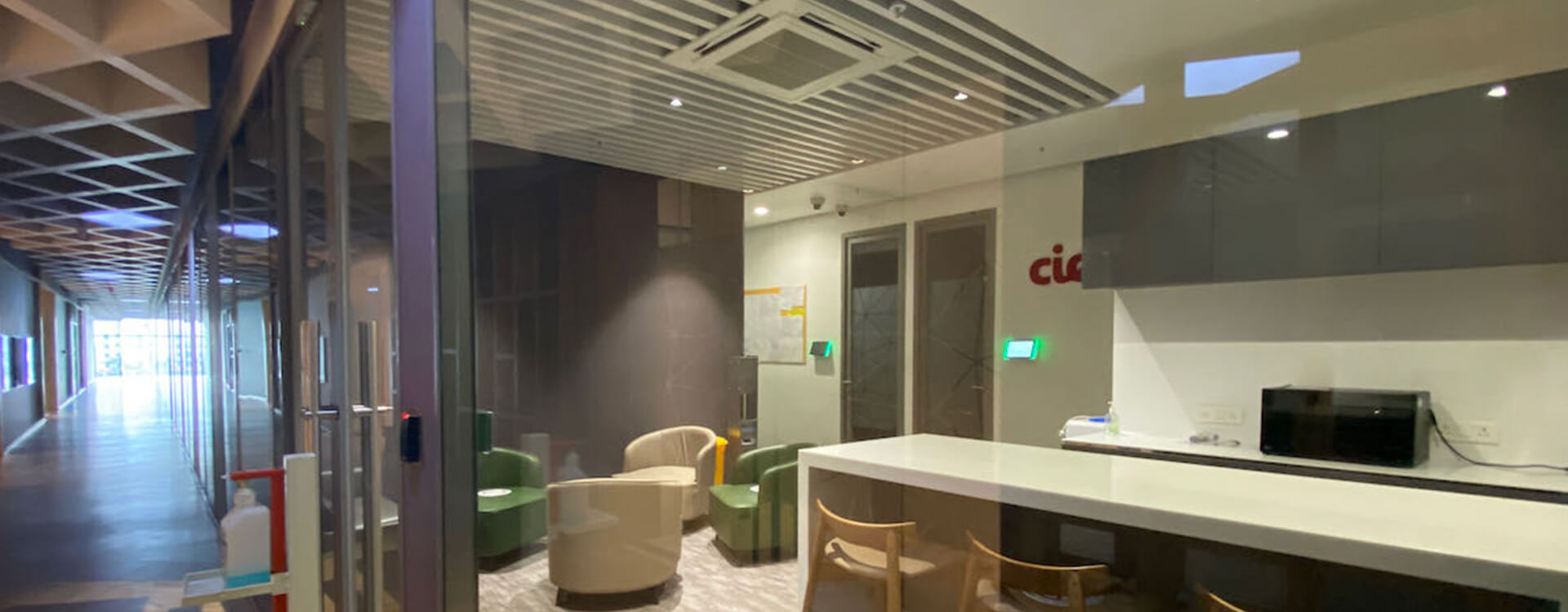There are over 20,000 coworking spaces globally, with over 3m seats. That’s a staggering number, given the humble beginnings of this industry which was originally meant for freelancers, creative-types, solopreneurs and early-stage startups. The growth trajectory is even more staggering – the number of spaces has grown by an annual compounded average growth rate (CAGR) of over 40% over the last decade, while the number of seats has grown by a rate of over 70% (CAGR) in the same period.
IWG Plc (Regus) and WeWork together raked up around $8bn of revenues in 2019, with around 4000 spaces and around 1.2m seats between them. We all know about the WeWork saga, Neumann-Son-face-off and the troubled IPO that wasn’t meant to be; with valuations dropping almost 90% from lofty expectations. Regus share price has also taken a nosedive recently, as COVID hit the markets in March 2020 – but a much more modest 50% off from recent highs. It wasn’t too long ago that Servcorp announced a surge in profits, but it has also suffered a bad fall since March. In fact, if we look at the share price charts of the listed players – it shows some worrying trends.
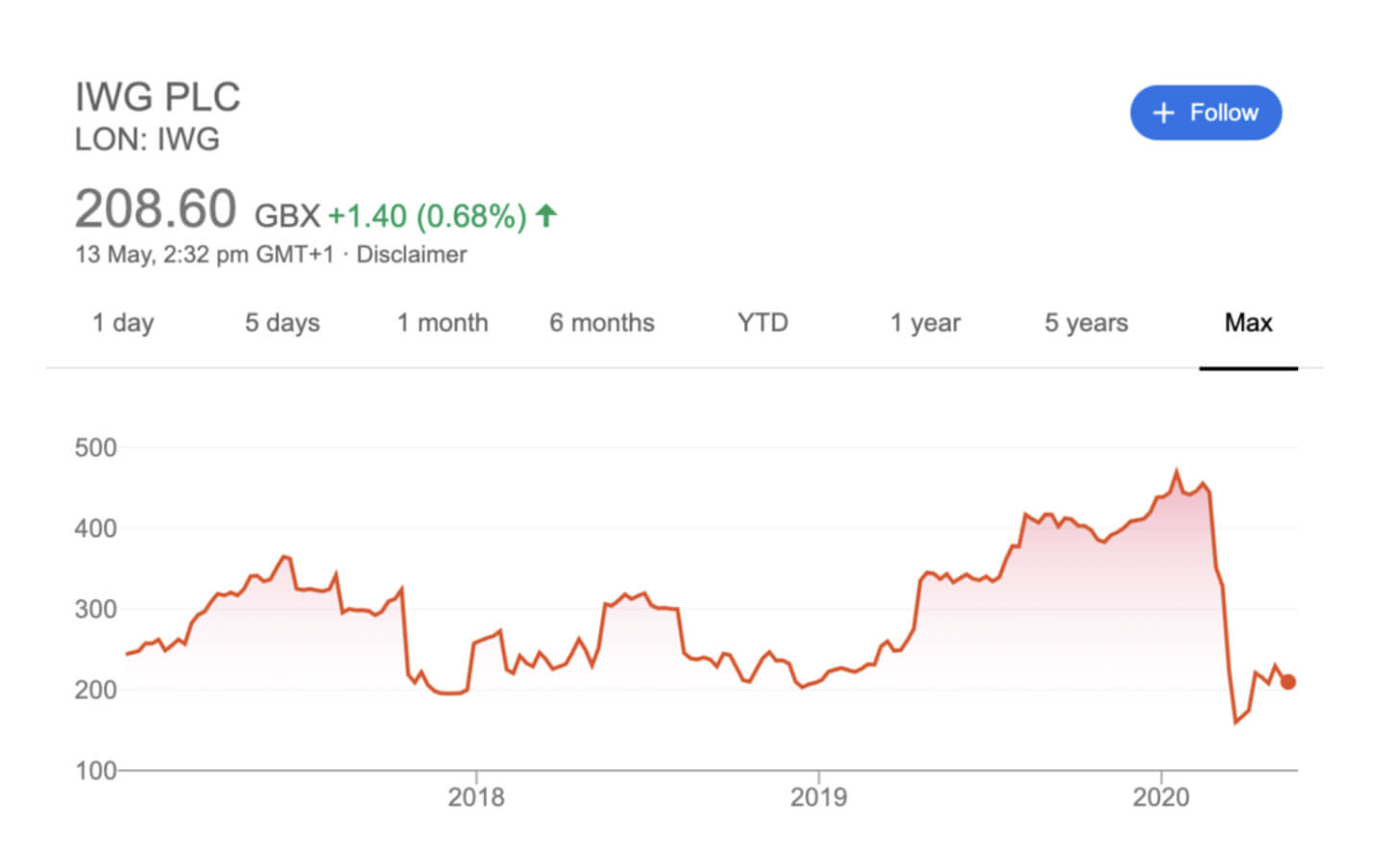
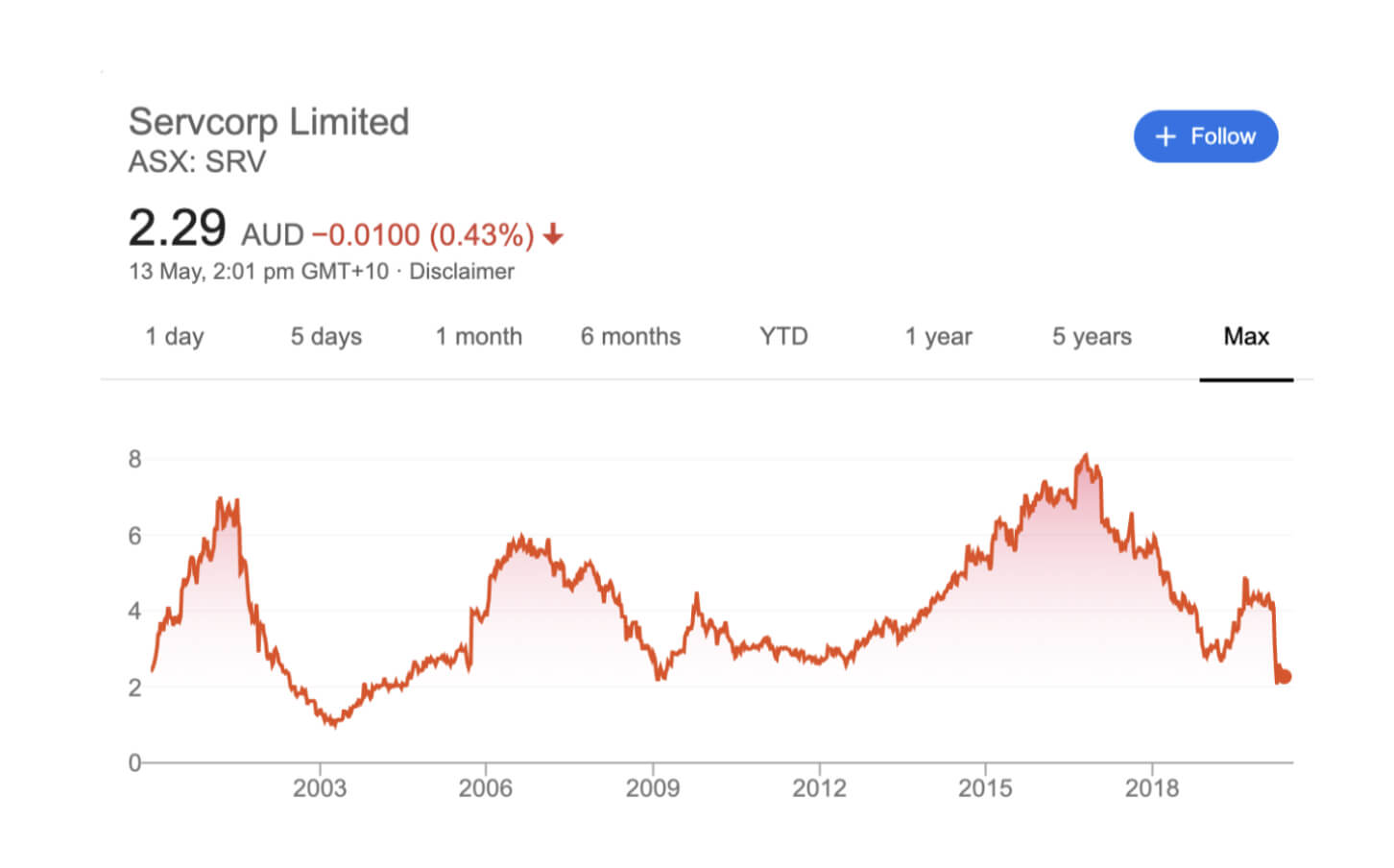
From these charts, it would seem that the flexible office business is doomed – after all Regus went bankrupt during the last economic downturn. The charts would also suggest that coworking is just a proxy for commercial real estate, which is very susceptible to economic cycles. Irrespective of the name you call it, flexible office, serviced office, shared workspace, managed office or a coworking space, it remains susceptible. No matter how much community, services or hospitality you inject into this real-estate as a service play – it’s still real estate and there’s no escaping the high correlation with economic cycles.
While doing those graphs above, I was taken back to my office days as an investment banker. I remember when we designed the office of the bank I helped to build in India. We took a keen interest in the layout, the growth plans, the decor, the look and feel of the space. Banking jobs are generally well paid, and therefore, more enjoyable than many others. Even preparing graphs like the ones above, and trying to find trends seemed like a fun thing to do, dull how it may seem, looking in from the outside. But, there was a thrill about going into work, to that temperature controlled environment, with well proportioned desks, no-expense spared infrastructure and amenities. It was a job, and I don’t think I could do that anymore – there was something about going to the office, which made it great. A lot of times it was the friends, the rituals, the early morning commute without traffic, but part of it was the space. The art work – a curated collection of photographs of Mumbai as an ode to this city and its history. The choice of the fabrics – what the colours said to us, or would say to visitors about us. How the well-lit white reception was so inviting, with the agarbatti smell lingering from the daily morning puja. The smell of the coffee machine as you passed it. A subconscious hint of recognition of how the false floor was raised with a gently sloping ramp rather than a step, to allow for disabled access. A grateful glance to when the meeting room door would gently click shut, without disturbing the meeting. That slow slump into the 14-way adjustable chair, where you would create something out of nothing that day. It sounds a bit like office porn, I know – but go back to your first workspace. No matter how rubbish, there was something about it that stayed with you. Wherever you are today, that’s where you started. Every workspace has a memory. An office is not just a space. It’s a memory.
Sorry about the short trip down memory lane. Irrespective of that, there is do doubt that the economic impact of COVID will weigh heavily on commercial real estate, and flexible space operators – at least in the short term. But as they say, every cloud has a silver lining….
No one wants an office?
The list of companies abandoning the need for an ‘office’ by announcing that their workforce can work remotely is on the rise. Twitter (forever), Google & Facebook (until 2021) and even other tech giants like Microsoft and Amazon announcing that most of their workers can work remotely. Twitter was already planning a move to a distributed workforce before COVID hit, but has now accelerated its process trending as #LoveWhereEverYouWork. Even more conservative firms like Morgan Stanley and Barclays have started looking at remote work as an alternative to their plush offices. Tata Consultancy Services has announced with a lot of fanfare that 75% of its 440k strong workforce will be able to use its Secure Borderless Workspaces technology solution to work remotely by 2025. There are some well-known companies like Basecamp and Buffer, who were already following a 100% remote workforce model – and have successfully done so for several years.
Remote working trends have been in place for a while, and COVID will accelerate their adoption across all businesses (that can) to work remotely, or at least more remotely than before. Technology has made this possible, and more probable as the future of work.
This all sounds quite onerous for the commercial real-estate sector, especially for offices. But, here’s a few points to consider:
- Remote work is not the same as work from home. It just means not coming into HQ.
- Remote work has been around for long, but many have not adopted it in the past.
- Offices will not completely disappear, but they will have to evolve
Work from Anywhere comes with its own set of challenges.
So, while the short term trends might show some due concern for the commercial office space sector, there must be a reason why the ‘office’ has managed to survive so many downturns. Let’s look into why?
Why do people have an office?
A conversation with a senior director at Oracle in India highlights that the main job of the plush offices was to impress clients and showcase products and services – part office, part experience centre. PWC spent millions of dollars building experience centres to showcase their digital transformation services. Another very well known technology company, known for its world-class CRM system has over 120 employees, but only 60 seats in the office – preferring its salespersons to be visiting clients and selling, rather than sitting in the office filling forms. Consulting firms like Accenture, Deloitte and EY have been optimising their workspaces to encourage people to spend more time on clients’ sites (billable hours) and/or work remotely when possible. Facebook and Google campuses around the world have long been known for their life-style offices, with amenities galore to motivate its workers by making work enjoyable, and every nook and corner appears to be filled with lone engineers or collaborating teams working on the next big thing. The JSW Steel office in BKC, Mumbai with its spotless white marble is a work of art and the various design touches showcase its identity of innovation and open culture, despite working in a very traditional, heavy industrial sector. Office spaces like the Gherkin and Canary Wharf in London define the landscape of the city. Premium Office addresses and buildings also serve to act as a status symbol, make a design/brand statement or simple vanity. At times, they help to attract bigger clients and talent. Recent hospitality trends in workspaces would suggest that talent retention is also impacted by your office address.
The interesting thing about offices is that they’ve been 50% under-utilised for decades. It’s also partly true that in some sectors, an office may not be required to complete most of the work that the staff need to. But, the office is also part of our social fabric. Work is what gives our life meaning. It’s our karma. We are born, we learn to walk, talk, read and write – so we can work, earn a living, and hopefully leave our mark on this world. Work gives our life meaning. And a workplace is where this meaning becomes tangible. The workplace and the people in it, are a real part of our lives, no matter who we are.
My father in law runs a car parts manufacturing factory in the West Midlands. He has been there for 40 years, straight. He retired last year. He still goes to the pub near work to catch up with some of the supervisors, everyday. I remember the day he took me for a tour of the factory – he talked about his rituals, his favourite corners and people. He could tell just from sound, that a machine is off-rhythm. He knew the sounds, the sights, the smells, the rhythms of the factory like the back of his hand. He didn’t need to tell me, but he missed his work, and his office. It was just as he’d left it – he had instructed them to. He would visit occasionally, just to be there and feel the rhythm. The office has memories, it has a vibe. It is more than just space.
I remember going to my Dad’s office when I was a little child. He had a big chair behind the largest cabin in the office, which he shared with his older brother. My grandfather sat in the next room with another one of my uncles. The office had a musty smell of dust settled between files with no intention of escaping. The sounds of type-writers tapping away, a teapot on the boil, movement, conversations, activity, progress, growth. I was hooked, and wanted to go everyday. It wasn’t a fancy workspace, but it had a purpose. Even though we don’t work the same way anymore, going to work has a purpose. The character of a workspace is different to that of a home. Yes, you can have a home office setup, but that’s not the essence of a workspace. A workspace is made up of people, of conversations, of stories, of learning, of politics, of affairs, of ideas, of connection, of memories.
No matter who you are, the office is not just a space you go to do a job and earn a living. It’s more than that. It’s where you meet colleagues, often where you meet your spouse or partner. It’s a place where you make friends – who may be colleagues, peers or clients. It’s where relationships & cultures are built, where trends are set and it turns the economic wheel round. It’s where informal conversations lead to brilliant ideas or new innovations. It’s where you sometimes work, sometimes chill, and sometimes socialise. A workspace is not just a space, it’s an emotion, a feeling. Ask the factory manager who retired after 40 years, or ask the new growth hacking freelancer who works out of a coworking space. Ask yourself, can you remember your first office, and every other office after that? Some maybe you would want to forget, but a workspace – it stays with you. An office is more than a space, it’s an emotion.
So, can we all really just work, remotely now, at the flick of a switch? Let’s see what remote work is all about.
Remote Work: Nothing new here.
The first major ‘remote work’ experiment (of modern times) was done by AT&T in the mid-90s. With the advent of the mobile phone, and pagers (remember those?) and other futuristic gizmos like fully functional computers you could carry around (now we call them laptops) – AT&T decided that large parts of its workforce could telecommute. That was the buzzword in 1994. Even IBM adopted these ideas, which were then considered radical.
“Work is where the phone is”, said AT&T Chairman, Robert Allan on Telecommuting day 1994. I wonder if he realised how right he was going to be in future.
The innovation was driven by a desire to cut costs. The cost of owning, renting or operating large offices was a strain on the finances of large organisations like AT&T and IBM. Furthermore, the lack of flexibility and workforce mobility trends led to a situation where either there were not enough seats, or too many empty ones. This made the high-cost line item pinch, even more, leading to a series of experiments on the way we work and the shape of the workspace etc. This includes:
- Sharing Desks Arrangements
- Open Plan Offices
- Hotel workspaces
- Satellite offices
- Telecommuting
- Homeworking
- Remote working (work from anywhere)
All came with their own benefits and challenges. This all changed with the mass adoption of the Internet, when work became a thing we do, rather than a place we go to. The modern workforce can, essentially, work from anywhere. Most knowledge-based ‘work’ we do today can be either automated or be done remotely. Interestingly, coworking spaces were made for exactly that purpose.
A brief history of coworking
As coworking spaces have scaled to become recognised as an independent asset class within commercial real estate, we seem to forget that fundamentally, the business model is designed around the remote worker. The early adopters of remote work were based in idyllic remote locations from Bali to Miami and were generally freelancers or ‘digital nomads’ – but the main value proposition was ‘freedom’ to work from ‘anywhere’. Essentially, the laptop is your workspace and the beach could be your office. All you needed was love (and wi-fi).
From freelancers, remote-working spread to startups looking for flexible workspace setups that could grow and shrink as per their requirements. This brought coworking to cities where most of the talent pools reside. It’s no surprise that some of the first coworking spaces were in San Francisco, London, Mumbai, Bangalore and other startup capitals of this world. High growth startups needed incubation and growth space – and coworking spaces flourished and grew larger. The urban freelancer also found their kombucha and micro-brewed coffee filled solace in the oversized armchairs of open spaces, while larger businesses tucked away their teams into private cabins or larger enterprise setups. Corporates have often used serviced offices to house their remote sales teams, or smaller city offices – this was the mainstay of businesses like Regus / Servcorp in the past. Seeing the flexibility, the benefit of converting their CAPEX to OPEX, and a quicker time to market – larger enterprises also started using coworking spaces for overflow, growth, incubation, city offices, sales offices, project offices or even a managed head office setup.
Enterprises also realised that disruptive ideas are unlikely to come from their head-offices, or traditional R&D departments, but from the young minds buzzing in these coworking environments which are built for collaboration. Some started or sponsored incubators alongside coworking spaces, and some moved their teams into shared environments to benefit from the perceived benefits of collaborative serendipity. Community and hospitality became the buzz words, and coworking spaces competed on who had the best coffee, free beer evenings, startup events, advanced technology, strongest community factor and other intangibles.
Somewhere along the way, we forgot. Coworking was made for remote working, to enable people to Work From Anywhere – irrespective of whether you’re a freelancer, a startup, a professional, or, a large enterprise.
Technology has changed the world of work, COVID has changed the world. While technology advances enabled work-from-anywhere, COVID enforces it. Herein, lies the opportunity for coworking and flexible space operators to become that ‘anywhere’ that people want to work from. Many argue that more often than not, ‘anywhere’ will be ‘home’ – as it solves the commute problem, it’s comfortable and it is the safest option in times of COVID. All undeniable facts, but there are several well-documented challenges with WFH.
Does work from home, work?
Challenges of WFH:
- Distractions: Having been on a webinar binge recently, I noticed that several people were joining these webinars from their cars. I must admit I was jealous, thinking they’re out and about while I was stuck at home in lock-down. Later, I found out they were using the car as an office because their small home with too many distractions was not conducive for a work call. While this problem is global, it is especially true of big cities in India like Mumbai, where joint families live in small flats, leaving very little space to carve out a work environment which will not be disrupted by kids, parents, uncles, grandparents or other distractions like doorbells, phone calls, house-help, visitors etc. To make things worse, schools are likely to remain closed for at least 3 months – which means working from home with kids.
- Isolation: Coworking spaces started as a cure for loneliness. Working from home can be quite isolating. It is difficult to stay motivated when working alone, especially if you’re stuck or facing some difficulty related to the work you’re doing. The informal support & encouragement you get from peers and coworkers bring a sense of belonging that is impossible to recreate over-scheduled zoom calls. These workplace social networks create a sense of belonging and a sense of purpose. The bonds created at a workplace are invaluable both professionally and personally – some of my best friends outside of university are those that I met at work.
- What of culture: The culture of an organisation is a huge differentiator when it comes to attracting and retaining top talent, partners, customers, stakeholders and also investments. It is an intangible ideology that defines the ability of the organisation and its stakeholders to relate to each other. Culture shapes how the organisation moves forward with a shared set of values and goals. Culture is created through interaction, collaboration, feeling, connection. It will take huge leaps and bounds in technology to transform interactions and virtual experiences to adjust for culture.
- Productivity & Performance Measurement: There are conflicting studies on this. Some research indicates that remote work can lead to increased productivity, sometimes this is attributed to the reduced commute time and less sick-days. Either way, it is difficult to measure productivity in a remote environment and this makes it difficult to measure performance or assign related rewards. From a personal perspective, remote work requires a high degree of self-discipline and motivation too. These challenges can lead to a degree of micro-management of remote workers, or a very result-oriented performance management system, which is not ideal for motivating employees.
- Communication and Collaboration: While communication tools are better than they have ever been before, the informal learning environment of a workspace cannot be matched online. Lack of facetime makes supervision, teamwork and learning and development more difficult. Given that India’s workforce is one of the youngest in the world, this face-time is not just a nice-to-have, but essential for the younger generation to develop new skills, have access to information and knowledge of their peers and learn from their presence and active mentorship. Collaboration, while possible online, is not the same either.
- Privacy / Security: My wife works in the CSR department of a large IT Services firm, and was recently asked to explain why she sent a file to another colleague (from the same department) using her Gmail address (Ans: her work email was down). The message from HR suggested that she could be fired for this security breach. Giving access to highly sensitive data to millions of remote workers is a huge challenge. For sure, technology, encryption and data security systems are much more advanced now. But, businesses are highly protective of their intellectual property and customer data, and in this regard, remote working may not be suitable, at least not yet.
- Infrastructure: The Internet and mobile access via 3G/4G is now more widespread than it has ever been. However, connectivity, speed and reliability is still patchy in several parts of the world, and especially so in India. Furthermore, the office environment with controlled temperature, adequate lighting, ergonomic chairs and other technology tools are difficult to recreate at home due to cost and space constraints.
For sure, we will work out systems like structured check-ins, AI-driven evaluation, online learning and development programs and several other digital alternatives to adjust to a new normal. We will adjust, we will figure out ways to make this work too. But, can it be the first choice? Aside from the challenges related to infrastructure and distractions, can we be the same person we are at work, at home? Some of us can, but I have a strong feeling that most of us cannot.
We need an office to go to, to become our work self, to think, act and talk differently and do different things. To create something, out of nothing.
It might look different to what we’ve been used to, but it can not be home, not forever, not even for long. Sure, some of us will be able to work from home successfully, and kudos to them. The rest, and might I guess, the majority, will look for an alternative to work-from-home. I think the future of work will definitely continue to have an HQ, a flex, and a home component. How this manifests for you, will be a matter of the type of work you do. It might be 20-55-25 as HQ-FLEX-WFH, or it could be 30-20-50. The gig economy might trend towards 5-20-75 – but even they will require a third space other than HQ and home, occasionally for themselves, or to meet others. This third space has always existed, but it’s always been the alternative – I believe COVID might be the catalyst that will push this third place, ‘flex’, into the top spot.
The HQ will shrink
For years, business leaders have been searching for a way to reduce head-office costs – at least on their watch. The office itself is a heavy line item, and advances in technology spiked with a COVID-kicker is likely to make the expensive office space a high-profile casualty. While many will promote a work-from-home culture, it will likely normalise to work-from-anywhere. The benefits of work-from-anywhere are similar to work-from-home, without some of the downsides.
- WFA lets people work near home, matching the commute benefit of WFH.
- WFA is comfortable, it is familiar, it has a support system, it is convenient.
- WFA has rituals, you can be your work self, meet people, connect, feel connected
- WFA has less distractions, less isolation, more peer learning, better infrastructure and ability to create a controlled environment.
I worked for a rookie Investment banker in the early days of my career. It was an alternative investment bank, set away from the gleaming office buildings of the city of London in an old Brewery in the hippie area of East London – Brick Lane. The pipes of the brewery were used as supports for linear desking systems. There were spiral staircases going into mezzanine level control centre cages, which acted as meeting rooms. Everything had been retro-fitted while maintaining the character of the brewery. Getting to work early hours on a Monday often meant stepping over hundreds of broken glass bottles from the partying crowds over the weekend. Bringing clients there should have been a nightmare, but it added a sense of character. The people who worked at the bank also oozed that East-London geezer charm, while being super at their work. The space created a sense of belonging, it motivated the team, and gave us all and our business an identity. We later got acquired and moved into a plush office in the City of London – the same building as the London Stock Exchange. It was gorgeous, the board rooms had views of St Paul’s Cathedral and the newly renovated Paternoster Square. It had a different character. When our parent bank came under some distress, the first thing to get cut was the excess space we had. It was quickly carved out and rented out to a third party. The head-office is dead.
The current crisis suggests a larger shift is coming – from HQ+Flex, to HQ+FLEX+WFH. Let’s hypothesize the possible outcomes of COVID on the current office market, to get more clarity on why the HQ will shrink.
Cost reduction
Businesses will look to reduce the CAPEX on things associated with setting up a large ‘office’. HQs will likely be kept for various reasons like bragging rights of a high-profile address, brand visibility and experience centres, with some hot-desking / hoteling style workspaces thrown in and many floors converted to meeting rooms or physical/virtual collaboration zones. But, the total space allocated to a HQ will shift downwards for sure. The Head-office was always a vanity metric, an under-utilised asset and we might now see parts of that asset shed away through sale, or leased away for alternative use.
De-densification
Over the years, office spaces have been filling more people into its spaces than ever before. While low-end work like call-centres and BPOs might have stretched the limits in this case, even head-offices have reduced their per person allocation by anywhere between 15%-50% over the last decade. This is not acceptable in a post-COVID world – and while social distancing norms might slowly fade away as we learn to live with COVID – de-densification in the workspace is here to stay. No matter how large or small your office is, it will suddenly be able to just 40%-60% of your workforce. So the cost of your office will go up, and leases will either need to be re-negotiated or cancelled. Several businesses will leave their current office setup and look for alternatives. While lay-offs are probably likely to happen, most businesses will still need more workspace. Some will urge their employees to WFH or WFA. In either scenario – the HQ, or the main office space, will shrink.
Quality
While premium properties will continue to demand a premium, a lot of office stock is of sub-par quality. This typically means lower hygiene standards, highly dense environments, bad air quality and non-ideal commutes. COVID will force a move to quality offices for those who can afford it, but the high cost will reduce the size and scope of the offices shifting to more premium spaces. The overall pie of ‘traditional lease’ offices will continue to shrink as the shift to quality limits supply and increases costs.
Flexibility
Commercial office leases have always been inflexible. The CRE industry was built on a promise of long-locked-in contracts which deliver rental yields to cover costs, and the ROI was the capital appreciation. The shift was happening even before COVID, where inflexible contracts were no longer in vogue, and flexible working was encroaching on the traditional lease models of CRE. At least for the foreseeable future, any new demand for CRE will be less traditional and more flexible than before. This too signals a shrinking of the HQ, and a rise of flex.
While no one can predict the future, one thing is certain – the return to work will be different to what it was before. Everyone I’ve asked – from the daily wage labourer, to the high-flying executive – all of them want to get back to work. The things they’re worried about are the commute, and the number of people they will come in contact with during that commute and through the day. And these concerns are real. Never before has going to work meant worrying about your life, unless your workplace was a battlefield of war. So, the concerns are warranted. The challenges of WFH have already been discussed, and the HQ will shrink. So, what does FLEX do to re-calibrate its offerings for the new normal, and earn its No. 1 spot?
The ‘Zoom’ moment for Coworking is NOW!
Coworking spaces are best placed to become THE ‘anywhere’ in WFA. There are a few changes the industry will need to make in order to cater to this new normal – but even before COVID, coworking spaces were becoming an acceptable alternative to leasing your ‘own’ office. COVID will only accelerate that process. There are several reasons for the same.
Solutions to CRE problems
Flex, as the name suggests makes commercial-real-estate flexible. This flexibility will be in high demand, but will require landlords to get involved in more actively managing and operating their assets. Landlords prefer to own an asset, rather than operate it. While some landlords have ventured into coworking themselves, most don’t see it as their core strength and will look for flexible space operators to share the burden.
Landlords will begin to offer more alternatives to traditional rental deals like a revenue share/profit share/operating contract models with flex-operators, even if they haven’t previously done so. The current uncertainty will make long-term leases a thing of the past except in sectors like warehousing, agriculture and manufacturing.
Both these factors will benefit coworkings spaces.
Solutions to office goers
Hub&Spoke
Coworking spaces can provide hub and spoke models of real-estate to businesses that are looking to shift their workforce to a WFA model. We might see more local, niche coworking spaces opening up across cities in residential suburbs to address demand for more ‘local’ coworking.
Location
Some coworking spaces like Redbrick Offices are located in highly accessible, Grade A buildings, with easy commute options available to its members. There are several benefits to this.
- Grade A buildings and Infrastructure: Landlords of Grade A buildings like World Trade Centre or The Capital BKC can afford to spend the type of money required for intensive and regular sanitisation and hygiene protocols, which will be a huge differentiator in the current environment.
- Locations, location, location: Easy access to spaces located near good commuter links and access to social and healthcare infrastructure nearby also helps to calm the minds of those traveling to office on a regular basis.
Cost sharing
De-densification, additional cleaning and sanitisation, increased flexibility – all add up to higher costs. Coworking spaces have been quite vocal about all the steps they’re taking with respect to de-densification and social distancing in order to make their workspaces ready to welcome members post-lockdown. While these activities lead to higher costs, the costs are shared by a higher number of businesses, makes ‘flex’ a more sustainable alternative.
Activity based workspaces
Coworking spaces will likely create many more meeting spaces and design spaces for specific activities. At Redbrick Offices, we have recording studios, training rooms, spaces built for recruitment drives, phone booths, study centres, small meeting rooms, standing meeting rooms, large board rooms, day-offices and are looking to create many more formats. I think coworking spaces can react to the changing needs of the market by innovating different product formats and solving solutions to space problems.
Flexibility and niches
Flexibility is built into coworking spaces, the focus will now be on getting discovered by a myriad of coworkers, freelancers, small and large business employees. There is a theory that remote work will drive home-makers back to work as well. Solopreneurs who favoured the coffee shop might be converted to a more controlled environment of the hot-desk environment in a coworking space. Employees of large businesses will look for spaces to work from near their home in a secure, safe and private manner. Artists will look for studios to rent by the week. Musicians might look to record their next album in a makeshift studio which is at a convenient location. The flexibility offered by coworking spaces will have to be complimented by niche offerings to solve problems for a much larger group of users.
Technology
Coworking spaces have long used technology to make their space usage more efficient, in their design and to connect their members. While these will remain important, another aspect of technology will come to the forefront. Technology that enables enterprises to create distributed workspaces using the hub-and-spoke model will have to be adopted and implemented at flexible workspaces to cater to privacy and IP concerns of larger enterprises. Technology will also play a large role in connecting people through video conferencing, virtual presence and other collaboration tools. Coworking spaces will not directly deploy these technologies, but will have to build systems and solutions to be able to connect to these technologies and cater to such demands from clients large and small.
Demand-Supply trend favourable
There’s no question in my mind, that for the foreseeable future – many of us will continue to ‘work from home’. But, over the long-term, I believe we will see the dust settle on this COVID crisis and the new normal will emerge. This new normal will surely be a mix of HQ-FLEX-WFH in most parts of the world. In India, I believe that FLEX will be a beneficiary of both HQ-shrinking and WFH-fatigue in the near-to-medium term. A lot of supply will come to the market from the likes of malls, cinemas, unrenewed leases, lease terminations, shrinking HQs, and maybe other CRE asset classes too. The demand-supply dynamics seem to be skewed in the favour of coworking spaces.
So, with minor changes in its business model and some healthy tailwinds – it would seem coworking is not only likely to survive, but it is likely to thrive and become a much larger chunk of the commercial real-estate world.
- Demand trends favour a move to flex from both WFH and HQ
- Supply dynamics suggest coworking operators will enjoy more bargaining power.
- Technology trends enable us to WFA, and favour remote work
- Socio-economic trends favour flexible workspaces
Short-term, there’s likely to be a lot of pain, and some consolidation too. But, the coworking operators with strong balance sheets, an enterprise coworking DNA and an adaptable, innovative team are the ones that are likely to come out of this crisis stronger. Let’s end with another two graphs. It took 2 months for online retail sales to double as a percentage of total retail sales and Zoom grew its daily active users 200% due to this crisis.
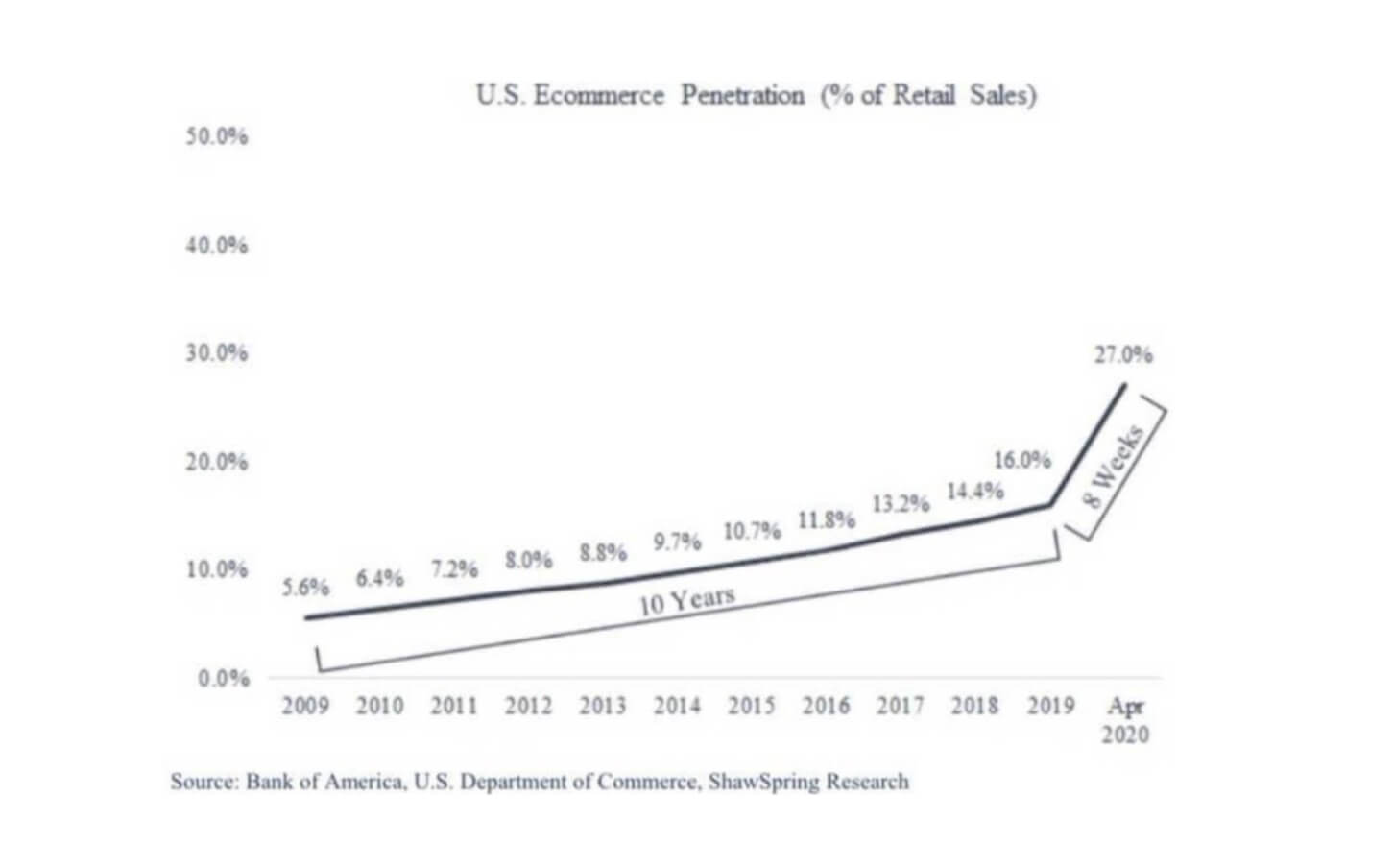
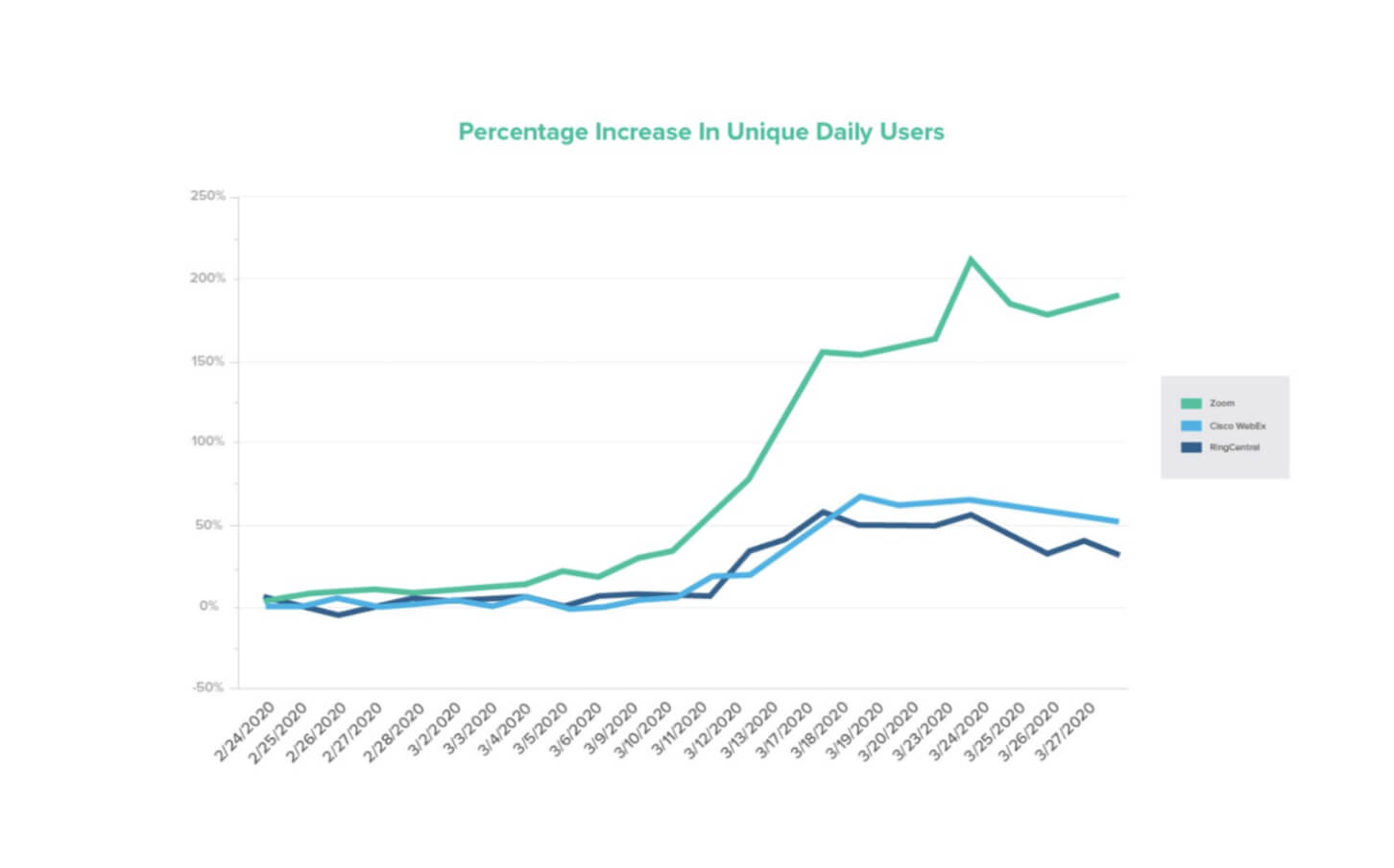
Coworking is ready for its Zoom moment. It is NOW.
